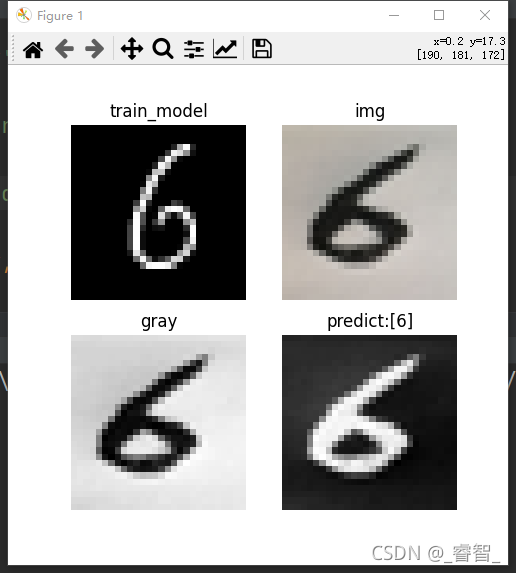
基礎(chǔ)理論
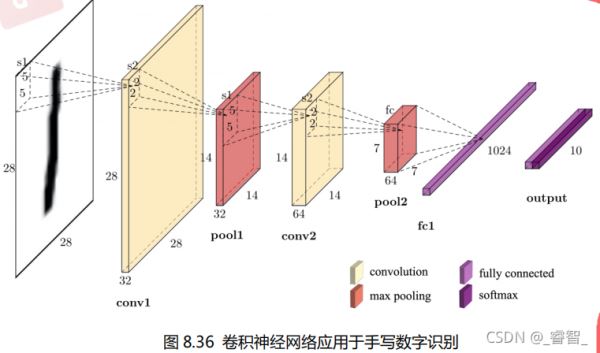
第一層:卷積層。
第二層:卷積層。
第三層:全連接層。
第四層:輸出層。
圖中原始的手寫數(shù)字的圖片是一張 28×28 的圖片,并且是黑白的,所以圖片的通道數(shù)是1,輸入數(shù)據(jù)是 28×28×1 的數(shù)據(jù),如果是彩色圖片,圖片的通道數(shù)就為 3。
該網(wǎng)絡(luò)結(jié)構(gòu)是一個 4 層的卷積神經(jīng)網(wǎng)絡(luò)(計(jì)算神經(jīng)網(wǎng)絡(luò)層數(shù)的時候,有權(quán)值的才算是一層,池化層就不能單獨(dú)算一層)(池化的計(jì)算是在卷積層中進(jìn)行的)。
對多張?zhí)卣鲌D求卷積,相當(dāng)于是同時對多張?zhí)卣鲌D進(jìn)行特征提取。
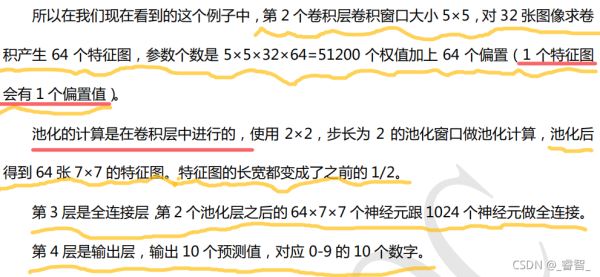
特征圖數(shù)量越多說明卷積網(wǎng)絡(luò)提取的特征數(shù)量越多,如果特征圖數(shù)量設(shè)置得太少容易出現(xiàn)欠擬合,如果特征圖數(shù)量設(shè)置得太多容易出現(xiàn)過擬合,所以需要設(shè)置為合適的數(shù)值。
一、訓(xùn)練CNN卷積神經(jīng)網(wǎng)絡(luò)
1、載入數(shù)據(jù)
# 1、載入數(shù)據(jù) mnist = tf.keras.datasets.mnist (train_data, train_target), (test_data, test_target) = mnist.load_data()
2、改變數(shù)據(jù)維度
注:在TensorFlow中,在做卷積的時候需要把數(shù)據(jù)變成4維的格式。
這4個維度分別是:數(shù)據(jù)數(shù)量,圖片高度,圖片寬度,圖片通道數(shù)。
# 3、歸一化(有助于提升訓(xùn)練速度) train_data = train_data/255.0 test_data = test_data/255.0
3、歸一化
# 3、歸一化(有助于提升訓(xùn)練速度) train_data = train_data/255.0 test_data = test_data/255.0
4、獨(dú)熱編碼
# 4、獨(dú)熱編碼 train_target = tf.keras.utils.to_categorical(train_target, num_classes=10) test_target = tf.keras.utils.to_categorical(test_target, num_classes=10) #10種結(jié)果
5、搭建CNN卷積神經(jīng)網(wǎng)絡(luò)
model = Sequential()
5-1、第一層:第一個卷積層
第一個卷積層:卷積層+池化層。
# 5-1、第一層:卷積層+池化層 # 第一個卷積層 model.add(Convolution2D(input_shape = (28,28,1), filters = 32, kernel_size = 5, strides = 1, padding = 'same', activation = 'relu')) # 卷積層 輸入數(shù)據(jù) 濾波器數(shù)量 卷積核大小 步長 填充數(shù)據(jù)(same padding) 激活函數(shù) # 第一個池化層 # pool_size model.add(MaxPooling2D(pool_size = 2, strides = 2, padding = 'same',)) # 池化層(最大池化) 池化窗口大小 步長 填充方式
5-2、第二層:第二個卷積層
# 5-2、第二層:卷積層+池化層 # 第二個卷積層 model.add(Convolution2D(64, 5, strides=1, padding='same', activation='relu')) # 64:濾波器個數(shù) 5:卷積窗口大小 # 第二個池化層 model.add(MaxPooling2D(2, 2, 'same'))
5-3、扁平化
把(64,7,7,64)數(shù)據(jù)變成:(64,7*7*64)。
flatten扁平化:
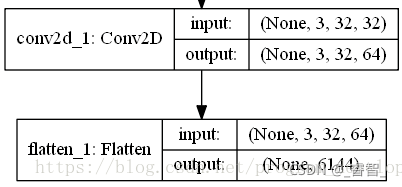
# 5-3、扁平化 (相當(dāng)于把(64,7,7,64)數(shù)據(jù)->(64,7*7*64)) model.add(Flatten())
5-4、第三層:第一個全連接層
# 5-4、第三層:第一個全連接層 model.add(Dense(1024,activation = 'relu')) model.add(Dropout(0.5))
5-5、第四層:第二個全連接層(輸出層)
# 5-5、第四層:第二個全連接層(輸出層) model.add(Dense(10, activation='softmax')) # 10:輸出神經(jīng)元個數(shù)
6、編譯
設(shè)置優(yōu)化器、損失函數(shù)、標(biāo)簽。
# 6、編譯 model.compile(optimizer=Adam(lr=1e-4), loss='categorical_crossentropy', metrics=['accuracy']) # 優(yōu)化器(adam) 損失函數(shù)(交叉熵?fù)p失函數(shù)) 標(biāo)簽
7、訓(xùn)練
# 7、訓(xùn)練 model.fit(train_data, train_target, batch_size=64, epochs=10, validation_data=(test_data, test_target))
8、保存模型
# 8、保存模型
model.save('mnist.h5')
效果:
Epoch 1/10
938/938 [==============================] - 142s 151ms/step - loss: 0.3319 - accuracy: 0.9055 - val_loss: 0.0895 - val_accuracy: 0.9728
Epoch 2/10
938/938 [==============================] - 158s 169ms/step - loss: 0.0911 - accuracy: 0.9721 - val_loss: 0.0515 - val_accuracy: 0.9830
Epoch 3/10
938/938 [==============================] - 146s 156ms/step - loss: 0.0629 - accuracy: 0.9807 - val_loss: 0.0389 - val_accuracy: 0.9874
Epoch 4/10
938/938 [==============================] - 120s 128ms/step - loss: 0.0498 - accuracy: 0.9848 - val_loss: 0.0337 - val_accuracy: 0.9889
Epoch 5/10
938/938 [==============================] - 119s 127ms/step - loss: 0.0424 - accuracy: 0.9869 - val_loss: 0.0273 - val_accuracy: 0.9898
Epoch 6/10
938/938 [==============================] - 129s 138ms/step - loss: 0.0338 - accuracy: 0.9897 - val_loss: 0.0270 - val_accuracy: 0.9907
Epoch 7/10
938/938 [==============================] - 124s 133ms/step - loss: 0.0302 - accuracy: 0.9904 - val_loss: 0.0234 - val_accuracy: 0.9917
Epoch 8/10
938/938 [==============================] - 132s 140ms/step - loss: 0.0264 - accuracy: 0.9916 - val_loss: 0.0240 - val_accuracy: 0.9913
Epoch 9/10
938/938 [==============================] - 139s 148ms/step - loss: 0.0233 - accuracy: 0.9926 - val_loss: 0.0235 - val_accuracy: 0.9919
Epoch 10/10
938/938 [==============================] - 139s 148ms/step - loss: 0.0208 - accuracy: 0.9937 - val_loss: 0.0215 - val_accuracy: 0.9924
可以發(fā)現(xiàn)訓(xùn)練10次以后,效果達(dá)到了99%+,還是比較不錯的。

代碼
# 手寫數(shù)字識別 -- CNN神經(jīng)網(wǎng)絡(luò)訓(xùn)練
import os
os.environ['TF_CPP_MIN_LOG_LEVEL']='2'
import tensorflow as tf
from tensorflow.keras.models import Sequential
from tensorflow.keras.layers import Dense,Dropout,Convolution2D,MaxPooling2D,Flatten
from tensorflow.keras.optimizers import Adam
# 1、載入數(shù)據(jù)
mnist = tf.keras.datasets.mnist
(train_data, train_target), (test_data, test_target) = mnist.load_data()
# 2、改變數(shù)據(jù)維度
train_data = train_data.reshape(-1, 28, 28, 1)
test_data = test_data.reshape(-1, 28, 28, 1)
# 注:在TensorFlow中,在做卷積的時候需要把數(shù)據(jù)變成4維的格式
# 這4個維度分別是:數(shù)據(jù)數(shù)量,圖片高度,圖片寬度,圖片通道數(shù)
# 3、歸一化(有助于提升訓(xùn)練速度)
train_data = train_data/255.0
test_data = test_data/255.0
# 4、獨(dú)熱編碼
train_target = tf.keras.utils.to_categorical(train_target, num_classes=10)
test_target = tf.keras.utils.to_categorical(test_target, num_classes=10) #10種結(jié)果
# 5、搭建CNN卷積神經(jīng)網(wǎng)絡(luò)
model = Sequential()
# 5-1、第一層:卷積層+池化層
# 第一個卷積層
model.add(Convolution2D(input_shape = (28,28,1), filters = 32, kernel_size = 5, strides = 1, padding = 'same', activation = 'relu'))
# 卷積層 輸入數(shù)據(jù) 濾波器數(shù)量 卷積核大小 步長 填充數(shù)據(jù)(same padding) 激活函數(shù)
# 第一個池化層 # pool_size
model.add(MaxPooling2D(pool_size = 2, strides = 2, padding = 'same',))
# 池化層(最大池化) 池化窗口大小 步長 填充方式
# 5-2、第二層:卷積層+池化層
# 第二個卷積層
model.add(Convolution2D(64, 5, strides=1, padding='same', activation='relu'))
# 64:濾波器個數(shù) 5:卷積窗口大小
# 第二個池化層
model.add(MaxPooling2D(2, 2, 'same'))
# 5-3、扁平化 (相當(dāng)于把(64,7,7,64)數(shù)據(jù)->(64,7*7*64))
model.add(Flatten())
# 5-4、第三層:第一個全連接層
model.add(Dense(1024, activation = 'relu'))
model.add(Dropout(0.5))
# 5-5、第四層:第二個全連接層(輸出層)
model.add(Dense(10, activation='softmax'))
# 10:輸出神經(jīng)元個數(shù)
# 6、編譯
model.compile(optimizer=Adam(lr=1e-4), loss='categorical_crossentropy', metrics=['accuracy'])
# 優(yōu)化器(adam) 損失函數(shù)(交叉熵?fù)p失函數(shù)) 標(biāo)簽
# 7、訓(xùn)練
model.fit(train_data, train_target, batch_size=64, epochs=10, validation_data=(test_data, test_target))
# 8、保存模型
model.save('mnist.h5')
二、識別自己的手寫數(shù)字(圖像)
1、載入數(shù)據(jù)
# 1、載入數(shù)據(jù) mnist = tf.keras.datasets.mnist (x_train, y_train), (x_test, y_test) = mnist.load_data()
數(shù)據(jù)集的圖片(之一):
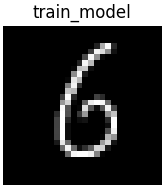
2、載入訓(xùn)練好的模型
# 2、載入訓(xùn)練好的模型
model = load_model('mnist.h5')
3、載入自己寫的數(shù)字圖片并設(shè)置大小
# 3、載入自己寫的數(shù)字圖片并設(shè)置大小
img = Image.open('6.jpg')
# 設(shè)置大小(和數(shù)據(jù)集的圖片一致)
img = img.resize((28, 28))
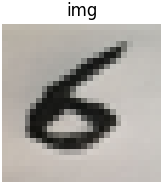
4、轉(zhuǎn)灰度圖
# 4、轉(zhuǎn)灰度圖
gray = np.array(img.convert('L')) #.convert('L'):轉(zhuǎn)灰度圖
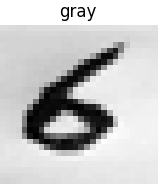
可以發(fā)現(xiàn)和數(shù)據(jù)集中的白底黑字差別很大,所以我們把它反轉(zhuǎn)一下:
5、轉(zhuǎn)黑底白字、數(shù)據(jù)歸一化
MNIST數(shù)據(jù)集中的數(shù)據(jù)都是黑底白字,且取值在0~1之間。
# 5、轉(zhuǎn)黑底白字、數(shù)據(jù)歸一化 gray_inv = (255-gray)/255.0
6、轉(zhuǎn)四維數(shù)據(jù)
CNN神經(jīng)網(wǎng)絡(luò)預(yù)測需要四維數(shù)據(jù)。
# 6、轉(zhuǎn)四維數(shù)據(jù)(CNN預(yù)測需要) image = gray_inv.reshape((1,28,28,1))
7、預(yù)測
# 7、預(yù)測
prediction = model.predict(image) # 預(yù)測
prediction = np.argmax(prediction,axis=1) # 找出最大值
print('預(yù)測結(jié)果:', prediction)
![]()
8、顯示圖像
# 8、顯示
# 設(shè)置plt圖表
f, ax = plt.subplots(3, 3, figsize=(7, 7))
# 顯示數(shù)據(jù)集圖像
ax[0][0].set_title('train_model')
ax[0][0].axis('off')
ax[0][0].imshow(x_train[18], 'gray')
# 顯示原圖
ax[0][1].set_title('img')
ax[0][1].axis('off')
ax[0][1].imshow(img, 'gray')
# 顯示灰度圖(白底黑字)
ax[0][2].set_title('gray')
ax[0][2].axis('off')
ax[0][2].imshow(gray, 'gray')
# 顯示灰度圖(黑底白字)
ax[1][0].set_title('gray')
ax[1][0].axis('off')
ax[1][0].imshow(gray_inv, 'gray')
plt.show()
效果展示

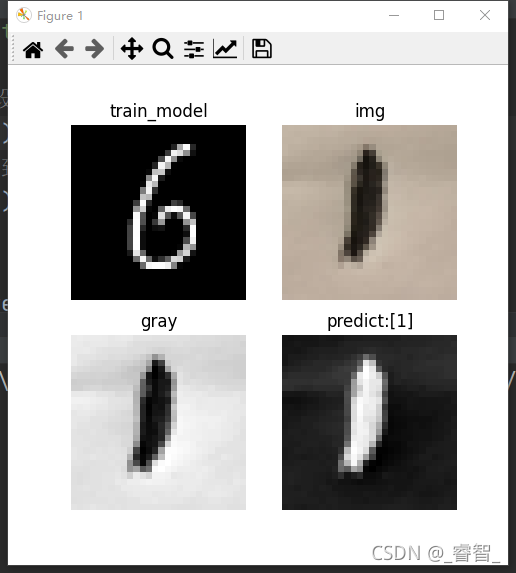
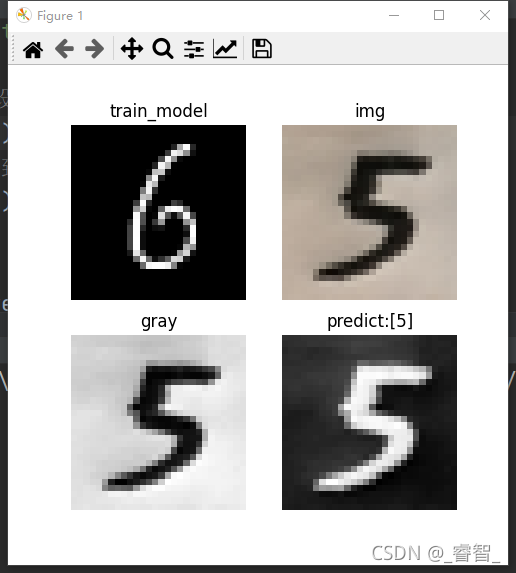
代碼
# 識別自己的手寫數(shù)字(圖像預(yù)測)
import os
os.environ['TF_CPP_MIN_LOG_LEVEL']='2'
import tensorflow as tf
from tensorflow.keras.models import load_model
import matplotlib.pyplot as plt
from PIL import Image
import numpy as np
# 1、載入數(shù)據(jù)
mnist = tf.keras.datasets.mnist
(x_train, y_train), (x_test, y_test) = mnist.load_data()
# 2、載入訓(xùn)練好的模型
model = load_model('mnist.h5')
# 3、載入自己寫的數(shù)字圖片并設(shè)置大小
img = Image.open('5.jpg')
# 設(shè)置大小(和數(shù)據(jù)集的圖片一致)
img = img.resize((28, 28))
# 4、轉(zhuǎn)灰度圖
gray = np.array(img.convert('L')) #.convert('L'):轉(zhuǎn)灰度圖
# 5、轉(zhuǎn)黑底白字、數(shù)據(jù)歸一化
gray_inv = (255-gray)/255.0
# 6、轉(zhuǎn)四維數(shù)據(jù)(CNN預(yù)測需要)
image = gray_inv.reshape((1,28,28,1))
# 7、預(yù)測
prediction = model.predict(image) # 預(yù)測
prediction = np.argmax(prediction,axis=1) # 找出最大值
print('預(yù)測結(jié)果:', prediction)
# 8、顯示
# 設(shè)置plt圖表
f, ax = plt.subplots(2, 2, figsize=(5, 5))
# 顯示數(shù)據(jù)集圖像
ax[0][0].set_title('train_model')
ax[0][0].axis('off')
ax[0][0].imshow(x_train[18], 'gray')
# 顯示原圖
ax[0][1].set_title('img')
ax[0][1].axis('off')
ax[0][1].imshow(img, 'gray')
# 顯示灰度圖(白底黑字)
ax[1][0].set_title('gray')
ax[1][0].axis('off')
ax[1][0].imshow(gray, 'gray')
# 顯示灰度圖(黑底白字)
ax[1][1].set_title(f'predict:{prediction}')
ax[1][1].axis('off')
ax[1][1].imshow(gray_inv, 'gray')
plt.show()
以上就是Python神經(jīng)網(wǎng)絡(luò)TensorFlow基于CNN卷積識別手寫數(shù)字的詳細(xì)內(nèi)容,更多關(guān)于TensorFlow識別手寫數(shù)字的資料請關(guān)注服務(wù)器之家其它相關(guān)文章!
原文鏈接:https://blog.csdn.net/great_yzl/article/details/120776341










